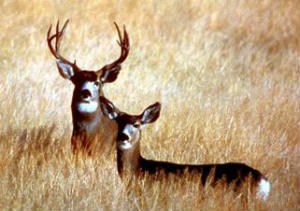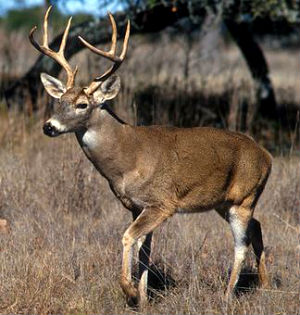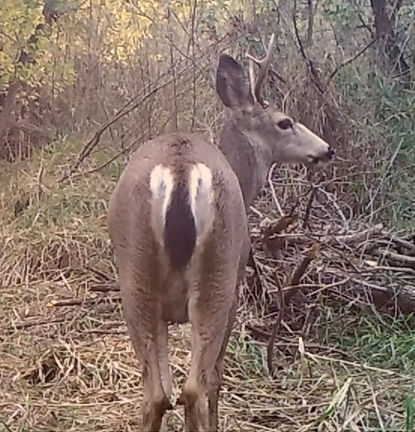White-tailed Deer x Mule Deer
Odocoileus virginianus x Odocoileus hemionus
Mammalian Hybrids
EUGENE M. MCCARTHY, PHD GENETICS, ΦΒΚ
 Mule Deer
Mule DeerOdocoileus hemionus
 White-tailed Deer
White-tailed DeerOdocoileus virginianus
Hybrids between white-tailed deer and mule deer have been produced many times in captivity and they also hybridize extensively in a natural setting. A broad hybrid zone extends along the western edge of the Great Plains from Mexico into western Canada (Ballinger et al. 1992; Bradley 2003; Carr et al. 1986; Hornbeck and Mahoney 2000; Hughes and Carr 1993; Stubblefield et al. 1986). The hybrids are at least partially fertile in both sexes. Most individuals within the zone are later-generation hybrids, and many that appear pure on the basis of morphology are hybrid in ancestry. Hybrids occur not only within the main zone, but also anywhere mule deer and whitetails come into regular contact.
In the vicinity of the zone O. hemionus mtDNA is present at high frequency in individuals that are phenotypically O. virginianus, presumably either because 1) hemionus females more commonly mate with virginianus males than hemionus males with virginianus females (perhaps because the size disparity of the partners is less in the former of these two pairings), or 2) because the progeny of such matings are more fertile than those resulting from the reciprocal cross (which seems to be the case; see below). Captive matings, however, show that the cross is reversible.
 A buck whitetail mule deer hybrid. Note the intermediate appearance of the tail.
A buck whitetail mule deer hybrid. Note the intermediate appearance of the tail.
Wishart et al. 1988 (p. 1665) found that an F₁ hybrid sired by an O. virginianus male produced mature spermatozoa (though many showed abnormalities), while an F₁ individual from the reciprocal cross produced none. However, Wishart et al. say (p. 1668) that even in this partially fertile individual, there were “irregularities in the cycle of epithelium, disturbances in spermiogenesis, and increased attrition of germ cells led to a reduced output of sperm, which were heavily afflicted with nuclear defects.” They also found fertility improved in a ¾ male backcross to white-tail (improved maturation, higher sperm output, and better sperm quality). In general, hybrids of all types, and not just those from this cross, exhibit elevated levels of defective sperm in comparison with pure parentals.
Nichol (1938) and Day (1980) thought the viability of hybrids, especially fawns, was inferior to that of pure types.
Dorcelaphus crooki Mearns, 1897 was based on a hybrid of this type, that is, the type specimen of crooki is a hybrid (Heffelfinger 2000).
|
Are human hybrids?
|
References: Anderson and Wallmo 1984; Ballinger et al. 1992; Bradley 2003; Carr and Hughes 1993; Carr et al. 1986; Cathey et al. 1998; Cronin et al. 1988; Cowan 1962; Day 1980; Derr 1991; Derr et al. 1991; Flower 1929b (p. 319); Hoffmeister 1962, 1986 (p. 541); Hornbeck and Mahoney 2000; Hughes and Carr 1993; International Zoo Yearbook 1971 (p. 284), 1978 (p. 396); Kramer 1973; McClymont et al. 1982; Nichol 1938; Nichols and Murrey 1973; Oceanak 1977; Stubblefield et al. 1986; Wishart 1980; Wishart et al. 1988; Zipperlen 1877.
Most shared on Macroevolution.net:
Human Origins: Are we hybrids?
On the Origins of New Forms of Life
Mammalian Hybrids
Cat-rabbit Hybrids: Fact or fiction?
Famous Biologists
Dog-cow Hybrids
Prothero: A Rebuttal
Branches of Biology
Dog-fox Hybrids